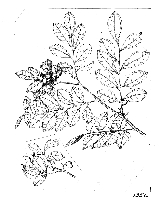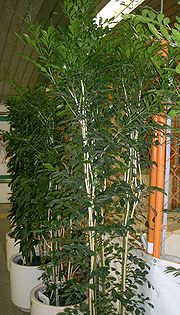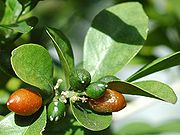
Murraya paniculata
Encyclopedia
Murraya paniculata, commonly called orange jasmine, is a tropical
, evergreen
plant bearing small, white, scented flowers, which is grown as an ornamental tree or hedge. Murraya is closely related to Citrus
.
for M. paniculata are:
Some of the common names include
Orange Jessamine, Chinese box, "mock orange
", Mock lime, Satinwood
,
or Lakeview Jasmine (mainly in Florida)

 Orange Jessamine is a small, tropical, evergreen tree or shrub growing up to 7 m tall. The plant flowers throughout the year. Its leaves are glabrous and glossy, occurring in 3-7 oddly pinnate
Orange Jessamine is a small, tropical, evergreen tree or shrub growing up to 7 m tall. The plant flowers throughout the year. Its leaves are glabrous and glossy, occurring in 3-7 oddly pinnate
leaflet
s which are elliptic to cuneate-obovate to rhombic. Flower
s are terminal, corymbose, few-flowered, dense and fragrant. Petals are 12–18 mm long, recurved and white (or fading cream). The fruit of Murraya paniculata is fleshy, oblong-ovoid, coloured red to orange, and grows up to 1 inch in length.
and Southeast Asia
, China
and Australasia
. It is naturalised in southern USA.
In the West, Murraya paniculata is cultured as an ornamental tree or hedge because of its hardiness, wide range of soil tolerance (M. paniculata may grow in alkaline, clayey, sandy, acid
ic and loam
y soils), and is suitable for larger hedges. The plant flowers throughout the years and produces small, fragrant flower clusters which attract bees, while the fruits attract small frugivorous
birds.
by its seeds. The fruits are eaten by birds, who then pass the seeds out in their stool
. It may also be artificially propagated by softwood cuttings.
s, scales, sooty mold
and whiteflies
.
M. paniculata is the preferred host to the insect pest Diaphorina citri, the citrus psyllid. This psyllid is the vector for the citrus greening
disease.
Tropics
The tropics is a region of the Earth surrounding the Equator. It is limited in latitude by the Tropic of Cancer in the northern hemisphere at approximately N and the Tropic of Capricorn in the southern hemisphere at S; these latitudes correspond to the axial tilt of the Earth...
, evergreen
Evergreen
In botany, an evergreen plant is a plant that has leaves in all seasons. This contrasts with deciduous plants, which completely lose their foliage during the winter or dry season.There are many different kinds of evergreen plants, both trees and shrubs...
plant bearing small, white, scented flowers, which is grown as an ornamental tree or hedge. Murraya is closely related to Citrus
Citrus
Citrus is a common term and genus of flowering plants in the rue family, Rutaceae. Citrus is believed to have originated in the part of Southeast Asia bordered by Northeastern India, Myanmar and the Yunnan province of China...
.
Synonyms and Common & Local Names
Taxonomical synonymsSynonym (taxonomy)
In scientific nomenclature, a synonym is a scientific name that is or was used for a taxon of organisms that also goes by a different scientific name. For example, Linnaeus was the first to give a scientific name to the Norway spruce, which he called Pinus abies...
for M. paniculata are:
- Chalcas exotica (L.Carolus LinnaeusCarl Linnaeus , also known after his ennoblement as , was a Swedish botanist, physician, and zoologist, who laid the foundations for the modern scheme of binomial nomenclature. He is known as the father of modern taxonomy, and is also considered one of the fathers of modern ecology...
) Millsp - Chalcas paniculata L. (basionym)
- Murraya exotica L.
Some of the common names include
Orange Jessamine, Chinese box, "mock orange
Mock Orange
Mock Orange typically means Philadelphus, a mostly Holarctic genus of shrubs. It can also refer to:* Bursaria spinosa , a small tree from Australia...
", Mock lime, Satinwood
Satinwood
Satinwood can mean the following:*A name for a wood that can be polished to a high gloss derived from certain species of the flowering plant family Rutaceae:**Chloroxylon swietenia, Ceylon satinwood or East Indian satinwood...
,
or Lakeview Jasmine (mainly in Florida)
- BurmeseBurmese languageThe Burmese language is the official language of Burma. Although the constitution officially recognizes it as the Myanmar language, most English speakers continue to refer to the language as Burmese. Burmese is the native language of the Bamar and related sub-ethnic groups of the Bamar, as well as...
: ယုဇန jṵ zana̰ (from PaliPáli- External links :* *...
yojana) - BengaliBengali languageBengali or Bangla is an eastern Indo-Aryan language. It is native to the region of eastern South Asia known as Bengal, which comprises present day Bangladesh, the Indian state of West Bengal, and parts of the Indian states of Tripura and Assam. It is written with the Bengali script...
: কামিনী - Hindi: Kamini (कामिनी)
- Indonesian: Kemuning
- Kannada: Kadu karibevu
- LaoLao languageLao or Laotian is a tonal language of the Tai–Kadai language family. It is the official language of Laos, and also spoken in the northeast of Thailand, where it is usually referred to as the Isan language. Being the primary language of the Lao people, Lao is also an important second language for...
: ແກ້ວ kɛ̂ːw - MalayMalay languageMalay is a major language of the Austronesian family. It is the official language of Malaysia , Indonesia , Brunei and Singapore...
: Kemuning - Malayalam: Maramulla
- Manipuri: Kamini kusum
- Marathi: Kunti (कुन्ती)
- Mandarin ChineseStandard MandarinStandard Chinese or Modern Standard Chinese, also known as Mandarin or Putonghua, is the official language of the People's Republic of China and Republic of China , and is one of the four official languages of Singapore....
: 月橘 (PinyinPinyinPinyin is the official system to transcribe Chinese characters into the Roman alphabet in China, Malaysia, Singapore and Taiwan. It is also often used to teach Mandarin Chinese and spell Chinese names in foreign publications and used as an input method to enter Chinese characters into...
: yué jú "moon tangerine") - TagalogTagalog languageTagalog is an Austronesian language spoken as a first language by a third of the population of the Philippines and as a second language by most of the rest. It is the first language of the Philippine region IV and of Metro Manila...
: Kamuning - Telugu: Nagagolungu
- Tamil: Kattu Kariyilai or Vengarai (வெங்காரை)
- ThaiThai languageThai , also known as Central Thai and Siamese, is the national and official language of Thailand and the native language of the Thai people, Thailand's dominant ethnic group. Thai is a member of the Tai group of the Tai–Kadai language family. Historical linguists have been unable to definitively...
: แก้ว kɛ̂ːw - VietnameseVietnamese languageVietnamese is the national and official language of Vietnam. It is the mother tongue of 86% of Vietnam's population, and of about three million overseas Vietnamese. It is also spoken as a second language by many ethnic minorities of Vietnam...
: Nguyệt quế.
Description


Pinnate
Pinnate is a term used to describe feather-like or multi-divided features arising from both sides of a common axis in plant or animal structures, and comes from the Latin word pinna meaning "feather", "wing", or "fin". A similar term is pectinate, which refers to a comb-like arrangement of parts...
leaflet
Leaflet
A leaflet in botany is a part of a compound leaf. A leaflet may resemble an entire leaf, but it is not borne on a stem as a leaf is, but rather on a vein of the whole leaf. Compound leaves are common in many plant families...
s which are elliptic to cuneate-obovate to rhombic. Flower
Flower
A flower, sometimes known as a bloom or blossom, is the reproductive structure found in flowering plants . The biological function of a flower is to effect reproduction, usually by providing a mechanism for the union of sperm with eggs...
s are terminal, corymbose, few-flowered, dense and fragrant. Petals are 12–18 mm long, recurved and white (or fading cream). The fruit of Murraya paniculata is fleshy, oblong-ovoid, coloured red to orange, and grows up to 1 inch in length.
Range
M. paniculata is a native of SouthSouth Asia
South Asia, also known as Southern Asia, is the southern region of the Asian continent, which comprises the sub-Himalayan countries and, for some authorities , also includes the adjoining countries to the west and the east...
and Southeast Asia
Southeast Asia
Southeast Asia, South-East Asia, South East Asia or Southeastern Asia is a subregion of Asia, consisting of the countries that are geographically south of China, east of India, west of New Guinea and north of Australia. The region lies on the intersection of geological plates, with heavy seismic...
, China
China
Chinese civilization may refer to:* China for more general discussion of the country.* Chinese culture* Greater China, the transnational community of ethnic Chinese.* History of China* Sinosphere, the area historically affected by Chinese culture...
and Australasia
Australasia
Australasia is a region of Oceania comprising Australia, New Zealand, the island of New Guinea, and neighbouring islands in the Pacific Ocean. The term was coined by Charles de Brosses in Histoire des navigations aux terres australes...
. It is naturalised in southern USA.
Uses
Traditionally, Murraya paniculata is used both in traditional medicine as an analgesic and for wood (for tool handles).In the West, Murraya paniculata is cultured as an ornamental tree or hedge because of its hardiness, wide range of soil tolerance (M. paniculata may grow in alkaline, clayey, sandy, acid
Acid
An acid is a substance which reacts with a base. Commonly, acids can be identified as tasting sour, reacting with metals such as calcium, and bases like sodium carbonate. Aqueous acids have a pH of less than 7, where an acid of lower pH is typically stronger, and turn blue litmus paper red...
ic and loam
Loam
Loam is soil composed of sand, silt, and clay in relatively even concentration . Loam soils generally contain more nutrients and humus than sandy soils, have better infiltration and drainage than silty soils, and are easier to till than clay soils...
y soils), and is suitable for larger hedges. The plant flowers throughout the years and produces small, fragrant flower clusters which attract bees, while the fruits attract small frugivorous
Frugivore
A frugivore is a fruit eater. It can be any type of herbivore or omnivore where fruit is a preferred food type. Because approximately 20% of all mammalian herbivores also eat fruit, frugivory is considered to be common among mammals. Since frugivores eat a lot of fruit they are highly dependent...
birds.
Propagation
The Orange Jessamine is sexually propagatedPlant propagation
Plant propagation is the process of creating new plants from a variety of sources: seeds, cuttings, bulbs and other plant parts. Plant propagation can also refer to the artificial or natural dispersal of plants.-Sexual propagation :...
by its seeds. The fruits are eaten by birds, who then pass the seeds out in their stool
Feces
Feces, faeces, or fæces is a waste product from an animal's digestive tract expelled through the anus or cloaca during defecation.-Etymology:...
. It may also be artificially propagated by softwood cuttings.
Diseases
M. paniculata is vulnerable to soil nematodeNematode
The nematodes or roundworms are the most diverse phylum of pseudocoelomates, and one of the most diverse of all animals. Nematode species are very difficult to distinguish; over 28,000 have been described, of which over 16,000 are parasitic. It has been estimated that the total number of nematode...
s, scales, sooty mold
Sooty mold
Sooty molds are Ascomycete fungi which grow on plant exudates and the sugary honeydew secreted by insects such as aphids, scales, the whitefly, and other insects which suck sap from their host plants. The name itself is descriptive, as sooty mold is a black, powdery coating adhering to the leaves...
and whiteflies
Whitefly
The whiteflies, comprising only the family Aleyrodidae, are small hemipterans. More than 1550 species have been described. Whiteflies typically feed on the underside of plant leaves.-Agricultural threat:...
.
M. paniculata is the preferred host to the insect pest Diaphorina citri, the citrus psyllid. This psyllid is the vector for the citrus greening
Citrus vein phloem degeneration
Huanglongbing , also known as HLB, citrus vein phloem degeneration , citrus greening disease, yellow shoot disease, leaf mottle yellows in the Philippines, libukin in Taiwan and citrus dieback in India, is probably the worst disease of citrus caused by a vectored pathogen...
disease.

